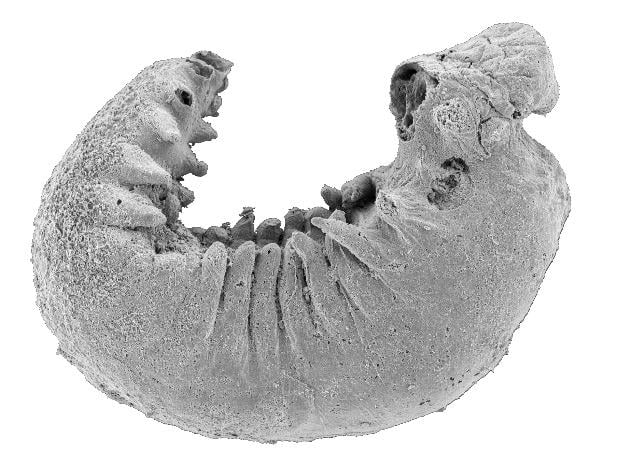An incredibly rare worm fossil dating back 520 million years has been discovered in China.
Change your life today. Don’t gamble on the future, act now, without delay.
Researchers from Durham University discovered an unexpected detail in the fossil: the ancient creature’s preserved brain.
This little larva flourished in the ancient Cambrian waters, oblivious to the role it would play in scientific history over a million years later.
This new fossilized species has been named Youti yuanshi, meaning “primitive larva” in Chinese.

Your imagination, our creation
It provides a glimpse into the evolutionary history of insects, spiders, crabs, and centipedes. Cambrian period was the time when the major animal groups known to exist today were first emerging.
“When I used to daydream about the one fossil I’d most like to discover, I’d always be thinking of an arthropod larva, because developmental data are just so central to understanding their evolution,” said Martin Smith, lead researcher from Durham University.
Preserved organs
This worm fossil belongs to the euarthropod group, which includes insects, spiders, and crabs. The examination also revealed that the organism died prematurely, while in its larval developmental phase. However, it was full of surprises.
The fossil has retained its internal organs in extraordinary condition despite being as small as a poppy seed.
Fragile organs are seldom preserved in fossil records. Smith stated that the odds of discovering larval fossils “are practically zero.” This makes the findings even more valuable.
Preserved organs
This worm fossil belongs to the euarthropod group, which includes insects, spiders, and crabs. The examination also revealed that the organism died prematurely, while in its larval developmental phase. However, it was full of surprises.
The fossil has retained its internal organs in extraordinary condition despite being as small as a poppy seed.
Fragile organs are seldom preserved in fossil records. Smith stated that the odds of discovering larval fossils “are practically zero.” This makes the findings even more valuable.
They examined the tiny fossilized remains using advanced synchrotron X-ray tomography scanning techniques. A primitive brain, digestive system, and even traces of nerves were unveiled. This helped to create the 3D images of the preserved anatomical features.
Smith added: “I already knew that this simple worm-like fossil was something special, but when I saw the amazing structures preserved under its skin, my jaw just dropped – how could these intricate features have avoided decay and still be here to see half a billion years later?”
Evolution of anthropods
This worm fossil — from one of the first lineages of arthropods — is an important piece of the evolutionary puzzle that led to insects, spiders, and crabs.
The specimen details how simple worm-like creatures evolved into complex arthropods with specialized limbs, eyes, and brains. Anthropods are a widespread category of animals today.
Interestingly, this tiny time capsule has shown that the building blocks for the complex brains of today’s arthropods were already present in this ancient creature.
The fossil also unveiled an ancient brain region known as the protocerebrum. As per the press release, this part turned into the complex, segmented head of modern arthropods with antennae, mouthparts, and eyes. This “complex head” structure allowed arthropods to adapt to diverse environments and become the dominant life forms of the Cambrian oceans.
The complexity of their anatomical structure surprised scientists, indicating that these early arthropod relatives were far more developed than thought.
“It’s always interesting to see what’s inside a sample using 3D imaging, but in this incredible tiny larva, natural fossilisation has achieved almost perfect preservation,” said Katherine Dobson, the study co-author from the University of Strathclyde, in the press release.







